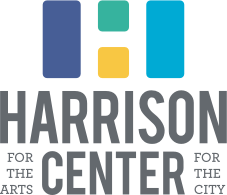Primary Colors
We Are Indy Arts is a local, African American arts collective that represents artists across a variety of disciplines. The exhibit currently on display in the Harrison Center’s Speck Gallery ranges from painting to sculpture, aerosol to collage, united under the themes of Black identity and culture.
Solid, by Rebecca Robinson. Mixed Media, 40” x 60”
These themes are realized through each artist’s own medium. Even when, culturally and globally, we all experience something in common, like the pandemic, it affects each of us differently and prompts different responses. Primary Colors, curated by artist Bruce Armstrong, reads as an interpretation of the last year of isolation, community, and racial injustice, as well as the Black experience in the U.S.
Some of the pieces in the show are jarring, like Anthony Radford’s “Storytime Boys and Girls (Once Upon a Time in Amerikkka).” The collage features the faces of many victims of police brutality and violent racism, alongside news clippings and references to genocide and lynching, as explicit as a noose hanging from the bottom edge of the piece. Inspiration for the piece came to Radford after months of isolated living and creating, as he considered the stories he would tell his grandchildren about the present, describing the “hatred and injustice all around us.”
In Living Color, by Bruce Armstrong. Collage, 48” x 60”
“In Living Color,” the collage by Bruce Armstrong, in contrast, focuses more on life than death, as the name would suggest. It is more contemplative than accusatory, like the words featured prominently on the piece: “What will the future look like?”
Some artists draw heavily on ancestral references of African tribalism, reinterpreting masks and symbols, as in Latoya Marlin’s “Fun Tribal Series.”
Others are personable, as in Gary Gee’s “Brown Sugar,” Omar Rashan’s “Healer from Honduras,” and Rebecca Robinson’s “Solid.” The mixed media piece by Robinson retains the textural quality common to her work, which often utilizes concrete, tar, and white latex. Her pieces in this exhibit are in color rather than her frequently used black and white, lending a nostalgic and intimate quality. They feel at home next to the warm, sunset hues of S.J. Holiday/Mijiza’s art, which makes use of natural wood grain to display skin tones in “Pass it On.”
Pass it on by S.J. Holiday/Mijiza. Acrylic on Wood, 24” x 48”
The collective aims to bridge the creative arts, community, and culture, through their involvement in city wide initiatives. Many of the We Are members have art currently on display at the Central Library, took part in the Black Lives Matter mural on Indiana Avenue, and painted boards for the Murals for Racial Justice project. Primary Colors is a fitting reflection of how the artists have experienced the past year— some in anger, some in frustration, uncertainty, protest, and some in love. Without directly asking the existential questions of “where are we” and “who are we?”, the show offers musings of the nuanced and varied identities of the artists and the Black community. The collective’s own mission says more: “We are the reality we create.”
Primary Colors by We Are Indy Arts will be on display in the Harrison Center’s Speck Gallery for the month of February. The exhibit can be viewed by appointment as well as in our online gallery, where all pieces are available for purchase.
Find more from the artists of We Are Indy Arts on their website, Facebook, and on Instagram @weare_indyarts.
A complete list of the artists featured in the group show:
Anthony Radford
Bruce Armstrong
Gary Gee
S.J. Holiday/Mijiza
Latoya Marlin
Omar Rashan
Rebecca Robinson



